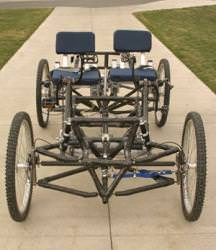You can tell that NASA is really serious about sending astronauts back to the Moon – they’re even working on the moonbuggies (I mean, rovers). In order to get the best designs possible, the agency is opening up the competition to student teams to design the best lunar rovers they can. The 15th annual race is going to be in Huntsville, Alabama on April 4-5, 2008. And who knows, maybe some of their good ideas might make it all the way to the Moon.
More than 40 student teams from the US and other countries have already registered for the 15th annual Great Moonbuggy Race. The students have to design, build and then race their own two-person lunar vehicles across a simulated surface of the Moon.
Here are the important rules:
- each buggy must be the work of students from a high school or institute of higher learning
- it must be human powered
- the unassembled vehicle must fit within a 1.2-metre (4-foot) cube
- the passengers must be able to carry it 6 metres (20 feet)
- the assembled vehicle has to be thinner than 1.2 metres (4 feet)
- it has to carry a bunch of simulated rover equipment, like a camera, antenna, and batteries
The total length of the course is about 1,100 metres (.7 miles), and strewn with rocks, craters and other lunar hazards. The team, consisting of a male and female, have to race their rover through the terrain as quickly as possible. Each team gets two runs, and the fastest times are the winners.
The three fastest-finishing buggies in both high school and college categories will win prizes from the race sponsors. There are also awards for the most unique moonbuggy design, best overall design, most improved team, best rookie team and most spirited team
There’s still time to register for the competition – registration ends on February 1st. If you’re interested in the rules and requirements, check out NASA’s website for the Great Moonbuggy Race.
Original Source: NASA News Release


“it must be human powered” ?
What does that have to do with the moon?
I dont expect them to hand out RTGs for students to use, but I would insist on moon capable technology. And guys in suits are not going to peddle around I don’t think. What ideas will they get, just general structure? What was wrong with the equipment used in the Apollo landings? I mean no major failures with any system other than the oxygen tank on Apollo 13, and the thrusters on Gemini 8. Leave it up to NASA to basically get us back to the 1960s, only billions of $ later. I guess the computers will be smaller though?
I recall reading quite a few years ago that less than 10%, maybe as low as 3%, of the engineering drawings from Project Apollo still exist. Even if we wanted to reuse the same approach, we would still be starting almost from scratch.
“And guys in suits are not going to peddle around I don’t think”
Maybe they will if they are wearing this sort of spacesuit
http://web.mit.edu/newsoffice/2007/biosuit-0716.html